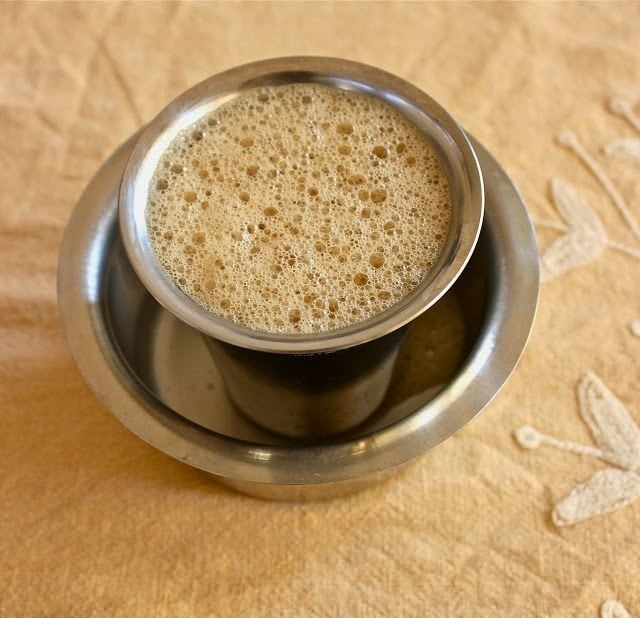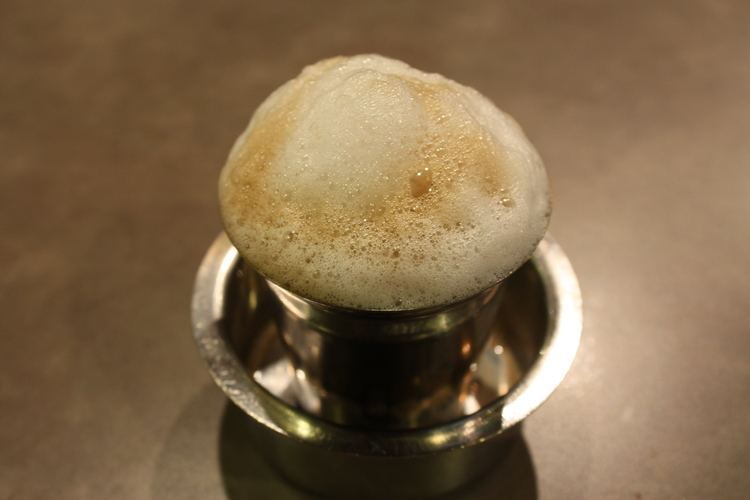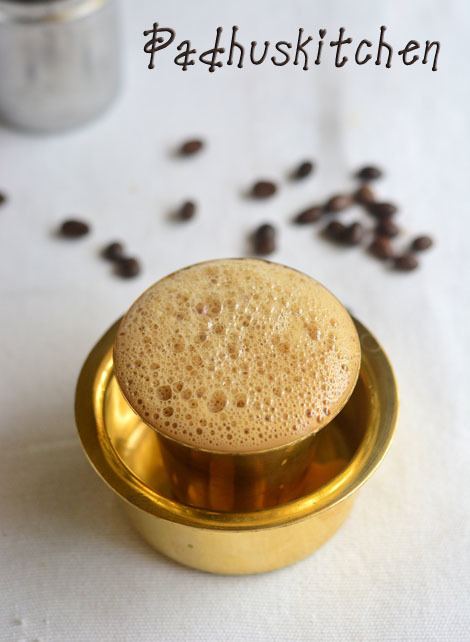Similar Specialty coffee, Robusta coffee, Flat white, Single‑origin coffee, Instant coffee | ||
How to make the south indian filter coffee
Indian filter coffee is a coffee drink made by mixing frothed and boiled milk with the decoction obtained by brewing finely ground coffee powder in a traditional Indian filter. The drink known as Kaapi, is the South Indian phonetic rendering of "coffee". The drink is also referred to as Mysore filter coffee, Kumbakonam degree coffee, Mylapore filter coffee or Madras kaapi. Outside of India the term "filter coffee" may refer to drip brew coffee, which is a distinct form of preparing coffee.
Contents
- How to make the south indian filter coffee
- South indian filter coffee by tarla dalal
- Beans
- Preparation
- Culture
- History
- Name
- References

South indian filter coffee by tarla dalal
Beans

The most commonly used coffee beans are arabica and robusta. These are grown in different states of South India, such as in the hills of Karnataka (Kodagu, Chikkamagalur and Hassan), Tamil Nadu (Nilgiris District, Yercaud and Kodaikanal), Kerala (Malabar region) and Andhra Pradesh (Araku Valley). The beans are usually medium-roasted and finely ground and blended with roasted chicory. The final coffee powder composition usually varies between 20 and 30 percent chicory, producing a distinct aroma and colour in the resulting coffee.
Preparation

South Indian filter coffee is brewed with a metal device that resembles two cylindrical cups, one of which has a pierced bottom that nests into the top of the "tumbler" cup, leaving ample room underneath to receive the brewed coffee. The upper cup has two removable parts: a pierced pressing disc with a central stem handle and a covering lid. (A similar device is used to brew Vietnamese coffee.)

The upper cup is loaded with freshly ground coffee. The grounds are then compressed (i.e., tamped) with the stemmed disc into a uniform layer across the cup's pierced bottom. The coarser the coffee grinds, the more one has to tamp the coffee to retain the same extraction. With the press disc left in place, the upper cup is nested into the top of the tumbler and boiling water is poured inside. The lid is placed on top, and the device is left to slowly drip the brewed coffee into the bottom. The chicory holds on to the hot water a little longer, letting the water dissolve and extract more of the coffee grinds.
The resulting brew is generally much stronger than Western drip/filter coffee, and often stronger than even espresso.
Traditionally, the coffee is consumed by adding 1–2 tablespoons of the brew to a cup of boiling milk with the preferred amount of sugar. The coffee is drunk from the tumbler (although a word of English origin, it seems to be the most commonly used name for this vessel), but is often cooled first with a dabarah - "dabarah" (also pronounced in some regions as 'davarah'): a wide metal saucer with lipped walls.
Coffee is typically served after pouring back and forth between the dabara and the tumbler in huge arc-like motions of the hand. This serves several purposes: mixing the ingredients (including sugar) thoroughly; cooling the hot coffee down to a sipping temperature; and most importantly, aerating the mix without introducing extra water (such as with a steam wand used for frothing cappucinos). An anecdote related to the distance between the pouring and receiving cup leads to another name for the drink, "Meter Coffee".
Culture
Coffee is something of a cultural icon in Karnataka, Andhra Pradesh especially the Coastal Andhra regions, Kerala and Tamil Nadu whereas in Telangana state Chai is a cultural icon. It is customary to offer a cup of coffee to any visitor. Coffee was originally introduced by Baba Budan to South India in the 17th century and became very popular under British rule. Until the middle of the 20th century traditional households would not use granulated sugar but used jaggery or honey in coffee. The coffee culture in India has had a renaissance of sorts with the establishment of popular and contemporary chains like Cafe Coffe Day and Starbucks.
History
Popular Indian lore says that on a pilgrimage to Mecca in the 16th century Baba Budan, a revered Sufi saint from Karnataka state, discovered for himself the wonders of coffee. In his eagerness to grow coffee himself at home, he smuggled seven coffee beans out of the Yemeni port of Mocha wrapped within his garments. On his return home, he planted the beans on the slopes of the Chandragiri Hills in Kadur district, Mysore State (present day Karnataka). This hill range was later named after him as the Baba Budan Hills, where his tomb can be visited by taking a short trip from Chikmagalur.
Rev. Edward Terry, chaplain to Sir Thomas Roe who was ambassador at the court of Emperor Jehangir, provides a detailed account of its usage (1616):
"many of the people there (in India), who are strict in their religion, drink no wine at all; but they use a liquor, more wholesome than pleasant, they call coffee, made by a black seed boiled in water, which turns it almost into the same colour, but doth very little alter the taste of the water. Notwithstanding it is very good to help digestion, to quicken the spirits, and to cleanse the blood."The British East India Company brought in fresh influences. David Burton, a food historian based in New Zealand writes in his book The Raj at Table (1993)
"India's first coffee house opened in Calcutta after the battle of Plassey in 1780. Soon after, John Jackson and Cottrell Barrett opened the original Madras Coffee House, which was followed in 1792 by the Exchange Coffee Tavern at the Muslim, waited at the mouth of the Madras Fort. The enterprising proprietor of the latter announced he was going to run his coffee house on the same lines as Lloyd's in London, by maintaining a register of the arrival and departure of ships, and offering Indian and European newspapers for his customers to read. Other houses also offered free use of billiard tables, recovering their costs with the high price of one rupee for a single dish of coffee."Indian filter coffee was popularised by the India Coffee Houses run by the Coffee Board of India since the mid-1940s. It became the drink of millions after the emergence of more popular Indian Coffee Houses in the mid-1950s.
Indian filter coffee even migrated overseas in the early 20th century to Malaysia and Singapore, where kopi tarik (pulled coffee) is a close cousin of the Madras filter coffee-by-the-yard / metre, and was introduced at roadside kopi tiams run originally by Indian Muslims.
